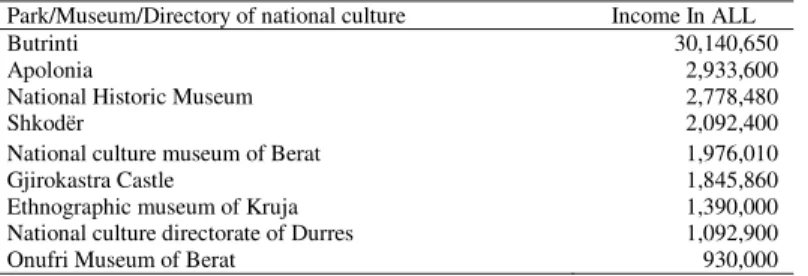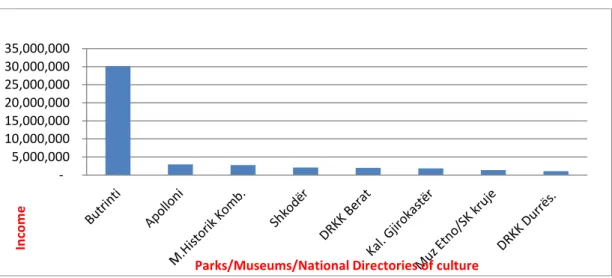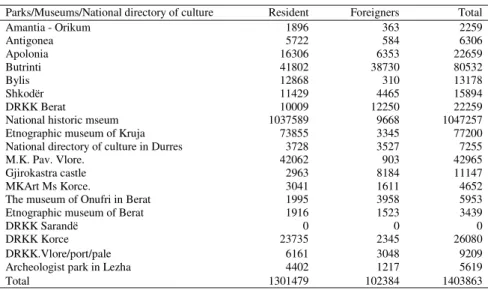Procedia - Social and Behavioral Sciences 188 ( 2015 ) 89 – 94
Available online at www.sciencedirect.com
ScienceDirect
1877-0428 © 2015 The Authors. Published by Elsevier Ltd. This is an open access article under the CC BY-NC-ND license (http://creativecommons.org/licenses/by-nc-nd/4.0/).
Peer-review under responsibility of the Scientific Committee of Heritage Sagittarius 2014. doi: 10.1016/j.sbspro.2015.03.342
Heritage as an alternative driver for sustainable development and economic recovery in South East Europe
Cultural heritage of Albania – a fabulous economic source for the
sustainable economic development of tourism
Elidiana Bashi
a,*
aUniversity of Shkodra “Luigj Gurakuqi”, Shkodër, Albania
Abstract
Historic countries and localities in Albania are a unique cultural heritage in the Mediterranean area. Albanian heritage remains a precious treasure, not only for Albanians, and the country history and its development but also for the whole balcony. In the “Cultural Heritage” – are included all the objects, with great historic value – that represent the history of the country where they come from. Mobile Cultural Heritage includes: Icons, old coins, ethnographic objects, costumes, musical instruments, statues and everything else found by the archaeological excavations. “Mobile Cultural Heritage” is always under protection in museums or archives, protected in the name of the law and in continuity under restoration. All Albanian cultural heritage – are under the pressure of nature and human destruction so they need to be protected, because it is: a main economic source to utilize for tourism, and attracting people from different countries, a natural heritage, that its anxiety shows the history of our country to the new coming generations, represents Albania with honour in Europe and wider.
© 2014 The Authors. Published by Elsevier Ltd. Selection and peer-review under responsibility of Institute of National Economy from Romanian Academy
Keywords: cultural heritage; tourism, law protection, sustainable economic development.
* Corresponding author. Tel.: +355 -224-2235 E-mail address: elidianapema@yahoo.com
© 2015 The Authors. Published by Elsevier Ltd. This is an open access article under the CC BY-NC-ND license (http://creativecommons.org/licenses/by-nc-nd/4.0/).
1.Introduction
All the human experiences, that have been developed and refined through centuries, are hidden somewhere in our land, that we know widely as “Cultural Heritage”. The demolition of any object or fact from the past should be considered an important loss for the development of our country. The fact is that Albanian should charge many responsibilities and consider this cultural and natural heritage as a valuable treasure and as an attractive source of information for the entire economy of the country. It is very necessary that this information is wide spread in Europe and wider, and to inherit it to the next generation – for the purpose to use it for tourism without damaging it, meanwhile.
During this paper, I am trying to verify this argument:
Ho: Diverse cultural heritage is a necessary resource, to reduce the poverty of Albania, to reach a sustainable
economic development of our country.
World conference, organized in Mexico on August 6, 1982, ha determined Mediterranean as a connection between nations and different cultures, as a mean of communication between the European culture and Islamic culture, and it recommended announcing Mediterranean Area “As the sea of the human civilization” Since then, UNESCO has developed, planned and realized many studies and programs that are focused on making partnerships.
2.Geographic and historic facts
English word “Mediterranean” comes from the Latin language Mediterranean that means “in the middle of the land”. The Mediterranean Sea has a total surface of 2.5 million km2 and its shore lies on 46,000 km. It is considered that today the Mediterranean states have more than 500,000,000 inhabitants. Mediterranean rayon has a wonderful shore, a rich history and a diversified culture; these reasons make it one of the first choices of many tourists in the world, attracting so about 1/3 of international tourists all over the world. In the Mediterranean area expanded their activity many historic civilizations such as: Roman imperial, Byzantine Imperial and the Turkish imperial – that made possible to leave to the new coming generations a very rich cultural heritage. Albania, as a Mediterranean country, through its cultural heritage has attracted tourists from year to years. The law no. 9048 date April7, 2003 on protection of cultural heritage, has its purpose protection of all components on cultural heritage in the territory of Albanian Republic. Since it was first implemented this law, it has had many essential improvements – and many recognitions from many other institutions to promote it.
3.Cultural heritage – and its income from tourism
During these last years the incoming flow of the tourists from foreign countries to Albania has increased. During 2012, touristic areas such as, parks, museums and local directories of national culture, as the past years have been visited from internal inhabitants as from foreigners. Income from Albanian is income generated from the tourism of resident visitors and non resident visitors, but with Albanian citizenship.
Table 1 Income from tourism in Albania for the year 2012, from the parks, Museums and directories of national culture - Source Ministry of tourism of Albania
Park/Museum/Directory of national culture Income In ALL
Butrinti 30,140,650 Apolonia 2,933,600
National Historic Museum 2,778,480
Shkodër 2,092,400 National culture museum of Berat 1,976,010
Gjirokastra Castle 1,845,860
Ethnographic museum of Kruja 1,390,000 National culture directorate of Durres 1,092,900
National Directorate of culture in Vlora 775,200 Ethnographic museum in Berat 348,040 National directorate of culture in Korca 339,000
Antigonea 272,000
M.K. Pav. Vlore. 236,200
National directorate of culture in Lezha 210,000
Bylis 170,700
Amantia - Orikum 119,800
National directorate of culture in Korca 18,600
According to this income data in Albanian lek – the number of Visitors that visited Albania during 2012 are:
• The most visited museum in Albania – is the national historic museum with about 1,037,589 resident visitors and 9,668 foreign residents. From these visitors, this museum generated about 2,778,448 Albanian lek incomes. This museum is located at the capital city of Albania and it is the biggest and the most visited museum in our country. It is one of the most precious treasures from the cultural heritage of our country. • The second place, according to the number of visitors during 2012, pertains to National Park of Butrinti,
with 41,802 resident visitors and 38,730 non residents’ visitors. Income generated from this museum reaches the figure of 30,140,650 Albanian lek – surpassing so the income generated from the national historic museum in the capital city.
The official data from the Ministry of Tourism of Albania show that that the historic national museum, even it is the most favourite place to visit from the foreigners, the income it generates, places it at the third place after the National Park of Butrint and the second is the ancient city of Apolonia.
This ancient city is located near the Adriatic Sea and generated during 2012 about 2,933,600 Albanian lek incomes. Not less important, according to the income are the most visited cities well – known for its cultural heritage, such as: Shkodra, Berati, The Gjirokastra Castle, Ethnographic Museum “Gjergj Kastrioti Skenderbej” in Kruja, Durres.
The graphic below I am going to depict the income generated from this parks and museums:
Fig. 1. Income from tourism and cultural heritage in Albania during year 2012, source Ministry of Tourism of Albania
Ͳ ϱ͕ϬϬϬ͕ϬϬϬ ϭϬ͕ϬϬϬ͕ϬϬϬ ϭϱ͕ϬϬϬ͕ϬϬϬ ϮϬ͕ϬϬϬ͕ϬϬϬ Ϯϱ͕ϬϬϬ͕ϬϬϬ ϯϬ͕ϬϬϬ͕ϬϬϬ ϯϱ͕ϬϬϬ͕ϬϬϬ /Ŷ ĐŽ ŵ Ğ WĂƌŬƐͬDƵƐĞƵŵƐͬEĂƚŝŽŶĂůŝƌĞĐƚŽƌŝĞƐŽĨĐƵůƚƵƌĞ
Fig. 2. Other income from tourism in Albania during 2012
Table 2 The number of the visitors that visited at least once, the cultural heritage in Albania is:
Parks/Museums/National directory of culture Resident Foreigners Total
Amantia - Orikum 1896 363 2259 Antigonea 5722 584 6306 Apolonia 16306 6353 22659 Butrinti 41802 38730 80532 Bylis 12868 310 13178 Shkodër 11429 4465 15894 DRKK Berat 10009 12250 22259
National historic mseum 1037589 9668 1047257 Etnographic museum of Kruja 73855 3345 77200 National directory of culture in Durres 3728 3527 7255
M.K. Pav. Vlore. 42062 903 42965
Gjirokastra castle 2963 8184 11147
MKArt Ms Korce. 3041 1611 4652
The museum of Onufri in Berat 1995 3958 5953 Etnographic museum of Berat 1916 1523 3439
DRKK Sarandë 0 0 0
DRKK Korce 23735 2345 26080
DRKK.Vlore/port/pale 6161 3048 9209
Archeologist park in Lezha 4402 1217 5619
Total 1301479 102384 1403863
Source: Ministry of Tourism
Ͳ ϭϬϬ͕ϬϬϬ ϮϬϬ͕ϬϬϬ ϯϬϬ͕ϬϬϬ ϰϬϬ͕ϬϬϬ ϱϬϬ͕ϬϬϬ ϲϬϬ͕ϬϬϬ ϳϬϬ͕ϬϬϬ ϴϬϬ͕ϬϬϬ ϵϬϬ͕ϬϬϬ ϭ͕ϬϬϬ͕ϬϬϬ /Ŷ ĐŽŵĞ ŝŶ >ďĂ Ŷŝ ĂŶ ůĞŬĞ WĂƌŬƐͬDƵƐĞƵŵƐͬEĂƚŝŽŶĂůĚŝƌĞĐƚŽƌŝĞƐŽĨĐƵůƚƵƌĞ
4.Why Albania?
Because of its natural beauties – the diversity of the Albanian territory. From the north Alps, natural and artificial lakes, to the seaside of Adriatic and Ionian sea. It’s a wild natural beauty that attracts tourists to visit them, at least once a life.
Cultural and archeological heritage – are one of the most valuable assets that make Albania, a nice destination where you can find at the same country: Ancient cities, museums, natural parks, etc. The amphitheatre of Butrint and the ancient city of Aplonia is under UNESCO protection. On the other hand the churches of Voskopoja are the most ancient of the rayon, bur unfortunately they don’t have the protection of the Albanian institutions.
Because of the progress Albania has made during this years of transition.
Because of the tradition. Without any argue, we are one of the Balkan’s country people that with care have handled and protected the tradition, as a clear evidence of our past history. This history testifies Albanian’s strong inherited culture. So for example, women at the north of Albania still wear the same dresses they wore 100 years before. This testifies a clear inheritance of tradition that makes them unique and very attractive to visitors. At the 21 – century – where the internet and mobile phones have invaded whole Albania, some people live as 100 years before, without these means of communication
Mass tourism – has not invaded Albania yet. This is a protection measure from the inhabitants. This lack of mass tourism – comes first, of all, from the lack of information. The foreigners that visit Albania – have heard of its cultural heritage from other that visited it before, or from some institutions that mention it sometimes.
It is payable – the Albanian tourism related to cultural heritage – is very cheap, compared to the other countries of Mediterranean Sea. Being a tourism organized by people itself, it is not very expensive.
5.Conclusion and recommendations
Referring the figures above from the ministry of Tourism, the income generated from the cultural heritage in Albania is very important. So it is really a source of economic development to generate income, to insure the reducing of the poverty, especially at the north of Albania
The map of cultural heritage institutions- shows that these institutions are spread almost each Albanian’s country. This means that you can visit a park, a museum or other elements of cultural heritage – almost each place in Albania. It remains duty of general institutions, such as: 1. Ministry of tourism, 2. Directories of cultural heritage ate local level – to make a detailed map of the places to visit from the cultural heritage in Albania
The cultural heritage in Albania – comes to visitors almost primitive – without any improvement or support from the main promoter institutions in Albania – this means that subventions should be used from different institutions in Albania – to expand this kind of tourism, because the places where this elements of cultural heritage are located, are the less populated and the poorest in Albania.
References
Country in Europe, Annex to the Programme Framework Document – Environment Chamber of industry and commerce. Book on sustainable development of the tourism in Albania
E. Gusmari, “Monitor” Mgazine, No. 26. (2007). 24 Hours in Albania Hall D. R. (2000): ‘Tourism as Sustainable Development? The Albanian Experience of ‘Transition’’, in international Journal of tourism Research, 2: 31-46
Hill M. R. (2006): ‘The European Union’s Emissions Trading Scheme: A Policy Response to the Kyoto Protocol’, in Journal of Contemporary European Studies, 14(3): 393-410
Holland J. (2000): ‘Consensus and Conflict: The Socioeconomic Challenge facing Sustainable Tourism Development in Southern Albania’, in Journal of Sustainable tourism, 8(6): 510-524
J. Elliot. Tourism: politics and public sector management.
Albanian republic tourism strategies, the ministry of tourism, May 2007


